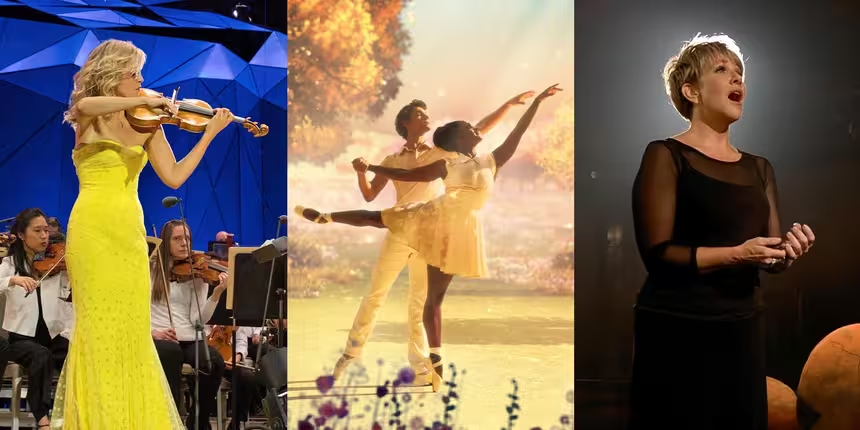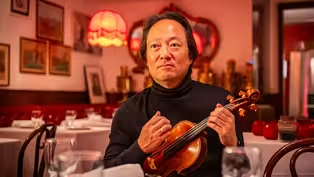
Rachmaninoff's Rhapsody on Paganini
Clip: Season 52 Episode 13 | 4m 5sVideo has Closed Captions
Yevgeny Sudbin and Scott Yoo explain Rachmaninoff's "Rhapsody on Paganini."
Yevgeny Sudbin and Scott Yoo explain the premise behind Rachmaninoff's "Rhapsody on Paganini" and then perform the piece.
Problems playing video? | Closed Captioning Feedback
Problems playing video? | Closed Captioning Feedback
Major series funding for GREAT PERFORMANCES is provided by The Joseph & Robert Cornell Memorial Foundation, the Anna-Maria and Stephen Kellen Arts Fund, the LuEsther T. Mertz Charitable Trust, Sue...

Rachmaninoff's Rhapsody on Paganini
Clip: Season 52 Episode 13 | 4m 5sVideo has Closed Captions
Yevgeny Sudbin and Scott Yoo explain the premise behind Rachmaninoff's "Rhapsody on Paganini" and then perform the piece.
Problems playing video? | Closed Captioning Feedback
How to Watch Great Performances
Great Performances is available to stream on pbs.org and the free PBS App, available on iPhone, Apple TV, Android TV, Android smartphones, Amazon Fire TV, Amazon Fire Tablet, Roku, Samsung Smart TV, and Vizio.
Buy Now

Great Performances Newsletter
Subscribe to the Great Performances newsletter to keep up with the latest full episodes to stream, exclusive content, and more!Providing Support for PBS.org
Learn Moreabout PBS online sponsorshipHave you heard this one before?
- Yeah.
This is really one of his most famous things.
Actually, Rachmaninoff borrowed or actually stole the theme from Paganini.
This is a violin piece.
It goes like this.
This is the theme.
♪♪ And that's where it ends, usually.
But Rachmaninoff repeats it.
♪♪ And it's funny, it just sounds like almost he was making fun of the violinist by having these little ornaments.
♪♪ Almost like his hitting the wrong notes.
Which is quite...
Probably, even if you're trying not to hit wrong notes, it's probably pretty easy to hit wrong notes in this piece, right?
I mean, this is pretty difficult for piano.
We're not supposed to talk about wrong notes.
No, but I mean, Rachmaninoff was one of the greatest living pianists.
So the first set of, I don't know, ten variations or so, they are very traditional.
I mean, you have one variation after the other.
And after that, he kind of takes off because there are so many elements in this piece that he is just so clever how he transforms.
It's almost like something is awakening to kind of take it off to the next level.
For example, a variation 13 is where Rachmaninoff actually changes the theme.
In the piano, you can hear the sound of the bells.
While in the violin you hear the main theme.
♪♪ ♪♪ ♪♪ ♪♪ ♪♪ ♪♪ What about variation 17?
Yeah, it's a very dark variation, but there is a reason why it is dark.
I will play a bit of that.
♪♪ ♪♪ ♪♪ ♪♪ ♪♪ ♪♪ ♪♪ ♪♪ Yeah.
And the end of it, it kind o goes on for quite a few pages.
Yeah.
Like a kind of slithering snake.
But then an amazing transformation happens at the end of it.
♪♪ The sun comes out.
♪♪ ♪♪ ♪♪ ♪♪ ♪♪ ♪♪ ♪♪ ♪♪ ♪♪ ♪♪ ♪♪ ♪♪ ♪♪ ♪♪ ♪♪ ♪♪ ♪♪ ♪♪ ♪♪ ♪♪ ♪♪
Now Hear This “Rachmaninoff Reborn” Preview
Video has Closed Captions
Preview: S52 Ep13 | 30s | Discover Rachmaninoff's reinvention as an American artist after losing everything in Russia. (30s)
Video has Closed Captions
Clip: S52 Ep13 | 3m 10s | Using an Ampico piano scroll, Scott Yoo watches Rachmaninoff play the piano. (3m 10s)
Providing Support for PBS.org
Learn Moreabout PBS online sponsorship
- Arts and Music

Experience America’s World War I story like never before in this electrifying live theatrical event.

- Arts and Music

Innovative musicians from every genre perform live in the longest-running music series.












Support for PBS provided by:
Major series funding for GREAT PERFORMANCES is provided by The Joseph & Robert Cornell Memorial Foundation, the Anna-Maria and Stephen Kellen Arts Fund, the LuEsther T. Mertz Charitable Trust, Sue...

